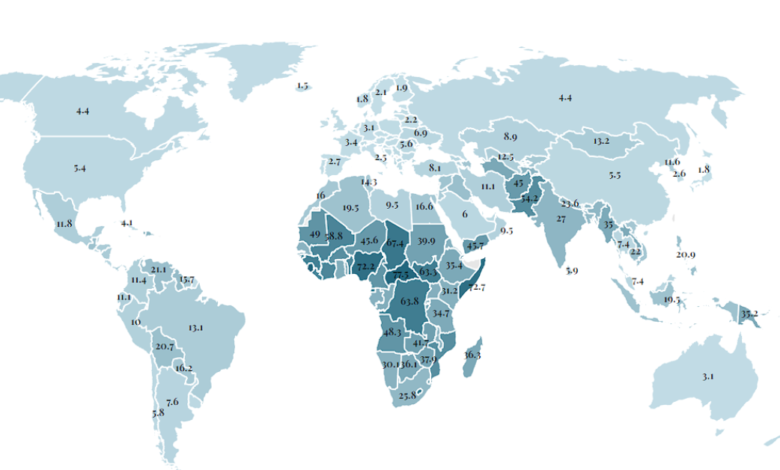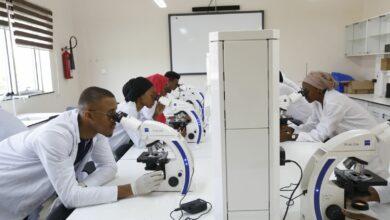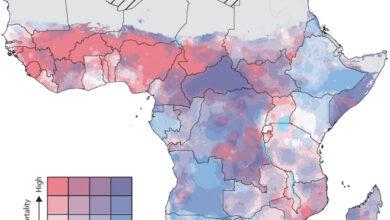
Top 15 Countries with high infant mortality rates in the World
The infant mortality rate, defined as the number of deaths of infants under one year old per 1,000 live births, is an essential indicator of the overall health of a country. A high infant mortality rate often reflects poor access to healthcare, nutrition, sanitation, and education for mothers and babies.InformationGuideNigeria
According to 2022 data from the United Nations Inter-agency Group for Child Mortality Estimation, the following 15 countries have the highest infant mortality rates in the world, all exceeding 50 deaths per 1,000 live births. This article will explore each country’s challenges and circumstances leading to high infant death rates.
👉 Relocate to Canada Today!
Live, Study and Work in Canada. No Payment is Required! Hurry Now click here to Apply >> Immigrate to CanadaTop 15 Countries with high infant mortality rates in the World
Here are the top 15 countries with high infant mortality rates in the world:
1. Afghanistan (103.06 deaths per 1,000 live births)
Afghanistan tops the list of countries with the highest infant mortality rates at over 100 deaths per 1,000 live births. After decades of conflict and instability, Afghanistan’s healthcare system is extremely inadequate with very limited medical facilities and personnel. Most births occur at home, often without access to skilled delivery attendants. Poverty and malnutrition are rampant, with many infants born underweight or stunted in growth.
Cultural practices like child marriage and high fertility rates also contribute to poor maternal and newborn health. Afghanistan also has very low rates of immunization, leaving many babies susceptible to life-threatening but vaccine-preventable diseases. The COVID-19 pandemic and political instability with the Taliban takeover have further weakened Afghanistan’s health systems and made access to care even more difficult.
Read Also: Top 15 Countries with Substantial Fishing Resources
2. Somalia (85.06 deaths per 1,000 live births)
Somalia’s infant mortality rate is estimated at over 85 deaths per 1,000 births, second only to Afghanistan. Like its neighbor, Somalia has also experienced civil war, droughts, famine, and political instability over the past few decades. This has led to a crippling of the healthcare system with constant shortages of supplies, equipment, and staff at medical facilities.Top 15 Countries with high infant mortality rates in the World
Preventable infectious diseases like pneumonia, diarrhea, malaria, measles, and tetanus account for most infant deaths in Somalia. Malnutrition makes babies more vulnerable to such diseases. Violence and displacement of people also disrupt vaccination and access to health services. Just 2 in 5 Somali infants are fully immunized. The lack of skilled birth attendants means deliveries at home often lead to fatal complications. Female genital mutilation practiced widely in Somalia also increases risks for both mothers and babies during childbirth.
3. Central African Republic (81.74 deaths per 1,000 live births)
As its name suggests, the Central African Republic (CAR) is located at the heart of the African continent and is one of the poorest countries in the world. Five decades of political instability and civil unrest have debilitated CAR’s health system and infrastructure. Continued armed conflict and displacement of populations have made humanitarian relief efforts extremely difficult.
Infant mortality rates are estimated at over 80 deaths per 1,000 live births, mostly from preventable diseases like malaria, pneumonia, diarrhea, and measles. Nearly half of children are chronically malnourished. Healthcare access is a major challenge with just four doctors available per 100,000 people. To improve child survival, CAR needs urgent interventions like improving food security, expanding immunization coverage, increasing access to essential medicines, and deploying more healthcare workers to provide basic maternal and newborn care.
👉 Relocate to Canada Today!
Live, Study and Work in Canada. No Payment is Required! Hurry Now click here to Apply >> Immigrate to Canada4. Equatorial Guinea (77.85 deaths per 1,000 live births)
Equatorial Guinea is a small Central African nation comprised of an island and a mainland region. Despite being one of sub-Saharan Africa’s largest oil producers, Equatorial Guinea still has very high rates of poverty and economic inequality. This means most of the population cannot access or afford quality healthcare. One in 10 children die before their fifth birthday. The leading causes of infant mortality are perinatal conditions, malaria, pneumonia, and diarrhea.15 Best Apple Gadgets in the Nigerian market
Malnutrition makes the situation worse, with about 15% of babies born with low birth weight. The country also has very few trained healthcare workers – around 1 doctor per 5,000 people. Rural areas which are home to around 60% of the population are especially deprived of health facilities and medical personnel. Improving neonatal care during delivery and in the first months of life is critical to saving babies in Equatorial Guinea.
Read Also: Top 15 Countries with Efficient Healthcare Delivery
5. Sierra Leone (72.3 deaths per 1,000 live births)
Sierra Leone has an infant mortality rate of about 72 deaths per 1,000 live births. Located on the west coast of Africa, it is one of the poorest countries and ranks very low on human development indicators. Underlying factors for high infant deaths include extreme poverty, low women’s status, inadequate healthcare access, and a high prevalence of communicable diseases like malaria and pneumonia.
During the 2013-2016 Ebola outbreak, Sierra Leone’s already fragile health system was severely strained leading to even more lack of access to routine maternal and child health services. As a result, vaccination rates dropped and the number of women delivering in hospitals declined. Malnutrition remains a huge threat too, with a third of children stunted. Current priorities are expanding immunization coverage, improving obstetric care and newborn health services, and increasing access to family planning to reduce neonatal deaths in Sierra Leone.
6. Niger (65.53 deaths per 1,000 live births)
Niger is a landlocked country in West Africa surrounded by the Sahara desert. It faces environmental challenges like droughts, famines, and desertification which negatively impact child nutrition and survival. Over 40% of children are chronically malnourished. Niger has the world’s highest fertility rate which strains resources and causes poor maternal health outcomes.Top 15 Best-Selling Apple Products in Nigeria
Over 60% of the population lives below the poverty line with limited access to clean water and sanitation. Common causes of newborn mortality are birth asphyxia, infections, complications from prematurity, and tetanus acquired during unclean home deliveries. Improving skilled birth attendance and emergency obstetric care are top priorities for Niger, increasing immunization, improving nutrition, and treating common childhood illnesses like diarrhea, malaria, and pneumonia.
7. Chad (63.99 deaths per 1,000 live births)
Chad has the seventh highest infant mortality rate globally at about 64 deaths for every 1,000 live births. Located in Central Africa, Chad is beset by widespread malnutrition, inadequate healthcare infrastructure, and high rates of infectious diseases like malaria and pneumonia which impact newborns and children. Access to clean water and sanitation is very poor, with only about half the population using basic drinking water sources.
Cultural practices like child marriage and high fertility rates also perpetuate poor maternal health and poverty. Conflict and insecurity obstruct access to healthcare. Chad needs to focus on women’s education and empowerment, along with improving child nutrition, immunization coverage, availability of emergency obstetric services, and delivery assistance by skilled attendants to lower its high rate of infant deaths.
8. South Sudan (61.63 deaths per 1,000 live births)
As the world’s newest nation, South Sudan also has one of the highest infant mortality rates. After decades of civil war with Sudan, South Sudan gained independence in 2011 but continues to face conflict, instability, poverty, and food insecurity. This has led to the collapse of health services. Most hospitals and clinics have either been destroyed in conflict or lack lifesaving medicines and equipment.105 Good Morning My Love Messages
Preventable diseases account for most infant deaths in South Sudan. The country has one of the world’s worst immunization rates and over 90% of births take place without skilled supervision. Families have little access to healthcare due to the shortage of doctors, nurses, hospitals, and drugs. To improve infant survival, South Sudan needs greater health investments and interventions targeting newborn and child health through pregnancy care, immunization, breastfeeding support, and treatment of pneumonia and diarrhea.
Read Also: Top 15 Countries with the Most Beautiful Ladies in Europe
9. Mozambique (59.77 deaths per 1,000 live births)
Mozambique is located in southeast Africa facing the Indian Ocean between South Africa and Tanzania. After gaining independence in 1975 from Portuguese rule, Mozambique suffered from a prolonged civil war which destroyed health infrastructure across the country. Today, it remains one of the poorest countries in the world with a per capita income of around $502.
Poverty, malnutrition, and lack of access to healthcare contribute to an infant mortality rate of nearly 60 per 1,000 live births. Understaffing at health facilities leads to low quality of care. Mozambique has one of the highest HIV/AIDS rates globally which also negatively impacts maternal and infant health. Key priorities for the country to lower its newborn mortality include expanding HIV services, community-based nutrition programs, immunization coverage, and programs to recognize and manage pregnancy/delivery complications.
10. Democratic Republic of the Congo (59.12 deaths per 1,000 live births)
The Democratic Republic of the Congo (DRC) located in Central Africa has been mired in conflict over several decades leading to humanitarian crises and the breakdown of the healthcare system. Most health indicators in DRC are among the worst in Africa including an infant mortality rate exceeding 59 deaths per 1,000 births. Malnutrition, infectious diseases like malaria and diarrhea, along with high rates of neonatal tetanus acquired during unhygienic home births contribute to most infant deaths.200 Romantic Message for Her
Less than half of women receive any prenatal care during pregnancy. Immunization coverage is extremely poor. The country also faces a shortage of medicines, equipment, and healthcare workers. Priorities for reducing newborn mortality include expanding facility-based deliveries, availability of skilled birth attendants and access to emergency obstetric care, prevention and treatment of leading causes of child death like pneumonia, malaria, and diarrhea, and improving rates of exclusive breastfeeding and immunization.
11. Mali (58.99 deaths per 1,000 live births)
Mali is a landlocked West African nation with most of its terrain in the hot and arid Sahara desert. Like its Sahel neighbors, Mali faces high poverty levels, food insecurity, and security threats. Most Malians reside in rural areas with very limited access to healthcare and a lack of transportation. Fertility rates are also very high with an average of 6 children per woman, the eighth highest globally.
These factors all contribute to an infant mortality rate exceeding 58 deaths per 1,000 live births. Leading causes of newborn death are infections, asphyxia, complications of prematurity, and congenital conditions. Expanding the availability of reproductive healthcare, increasing skilled birth attendance and access to emergency obstetric care, and improving breastfeeding and treatment of newborn infections via community health workers are key priority areas for Mali to reduce its developing mortality burden.
12. Angola (57.2 deaths per 1,000 live births)
Angola is a southern African nation that after gaining independence from Portugal in 1975 underwent a prolonged civil war until 2002 destroying infrastructure and displacing populations. Healthcare was severely disrupted with many Angolans lacking access to even basic medical services. Though progress has been made in recent years, Angola still has very high rates of infant and under-5 mortality.
Read Also: Top 15 Countries with high infant mortality rates in Africa
The infant mortality rate is around 57 deaths per 1,000 live births mostly stemming from preventable causes like diarrhea, malaria, pneumonia, and malnutrition. Birth complications, newborn sepsis, and tetanus are also significant killers. Priorities for better child survival include expanding immunization coverage, availability of skilled healthcare workers, increasing facility-based deliveries, and improving nutrition and breastfeeding practices.NYSC Portal
13. Comoros (56.01 deaths per 1,000 live births)
The Union of Comoros is a small island nation located between Madagascar and Mozambique in the Indian Ocean. Political instability has stymied social development in Comoros leading to inadequate healthcare and a high disease burden. About half the population lives below the poverty line with limited access to safe water, sanitation, prenatal care, and delivery assistance by trained personnel.
Infant mortality is around 56 per 1,000 live births, resulting mainly from preventable infectious diseases and neonatal disorders aggravated by undernutrition and suboptimal breastfeeding. Major priorities for Comoros include strengthening routine immunization, improving maternal nutrition and anemia prevention, promoting skilled birth attendance and facility-based delivery, and increasing the availability of essential medications, equipment, and staff at health centers.
14. Benin (54.33 deaths per 1,000 live births)
Benin is a West African low-income country surrounded by nations like Nigeria, Niger, Burkina Faso, and Togo. Forty percent of the population lives below the poverty line. Just over half of births take place at home often without a skilled attendant.
The infant mortality rate is 54 deaths per 1,000 live births, stemming mainly from preventable causes like respiratory infections, malaria, diarrhea, and complications from premature birth. Less than 20% of infants are exclusively breastfed. Priorities for Benin include expanding facility-based deliveries, improving the quality of care around childbirth and for small and sick babies, increasing vaccination coverage, promoting breastfeeding, and implementing public health measures to prevent malaria and diarrhea.JAMB Portal
15. Malawi (53.99 deaths per 1,000 live births)
Malawi is a landlocked country in southeast Africa that is considered to be one of the world’s most densely populated and least developed countries. Poverty levels are very high in rural areas which lack basic infrastructure like roads and healthcare facilities. This restricts women’s access to antenatal care and delivery services by skilled personnel. Only about 60% of women receive the recommended 4 prenatal visits.
Read Also: Top 15 Countries with high unemployment rates in Africa
Approximately 53 out of 1,000 Malawian babies die within their first year, mainly due to complications of preterm birth, birth asphyxia, infections, and congenital defects. Priorities to reduce Malawi’s high newborn mortality rate include improving access to emergency obstetric care, quality of delivery and postnatal services for mothers and babies, prevention and management of major childhood illnesses, increasing rates of early and exclusive breastfeeding, and expanding immunization coverage.
Conclusion
To significantly reduce infant mortality rates, the countries profiled here must strengthen their health systems and infrastructure, expand access to care and improve underlying socioeconomic conditions. Vital interventions include increasing the healthcare workforce, facilities, and transportation; promoting skilled birth attendance and emergency obstetric care; improving nutrition and anemia prevention for mothers; implementing proper breastfeeding, sanitation, and immunization; and advancing prevention and management of leading childhood illnesses like pneumonia, malaria, and diarrhea. With robust implementation, adequate funding, and multi-sector cooperation, even resource-limited nations can make rapid progress in decreasing newborn deaths and meeting global development goals.
Check: JAMB Result
Check and Confirm: How Much is Dollar to Naira








